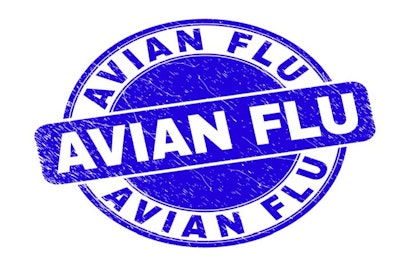
Over the past 10 days, seven European countries have reported the presence of highly pathogenic avian influenza (HPAI) virus in commercial poultry flocks.
Within days of an official warning issued to the European poultry sector about the growing threat of highly pathogenic avian influenza (HPAI), seven nations in the region had registered new outbreaks of the disease on commercial farms.
For each of these countries, cases reported to the World Organisation for Animal Health (WOAH) represented the return of HPAI following a hiatus to at least one region. In all of the outbreaks in Europe since the fall, the virus has been identified as one of the H5N1 serotype.
HPAI hits poultry flocks across Europe
Over the past week, the country confirming to WOAH the highest number of HPAI outbreaks in poultry was Germany. Around 88,000 domestic birds were directly impacted by the disease at seven premises.
For the central-northern state of Saxony-Anhalt, the outbreak in more than 20,300 chickens was the first for more than eight months. There were further cases of the winter in other northern states — Schleswig-Holstein, Mecklenburg-West Pomerania, and Lower Saxony — as well as in the west on North Rhine-Westphalia.
Following the devastation caused by HPAI in previous years, the first outbreak among French poultry flocks was confirmed during the last week of November.
The presence of the H5N1 virus was first detected at a turkey farm in Morbihan, a department in the northwestern region of Brittany.
The national outbreak currently stands at six following confirmation to WOAH of five further outbreaks. Three of these involved turkey flocks in Morbihan. Other affected premises were in the northernmost region of Hauts-de-France: another turkey farm in the department of Somme, and the latest outbreak was confirmed on December 18 in 303,700 laying hens in Nord.
Among the latest outbreaks to be recorded in Hungary was the first in the northwestern county of Gyor-Moson-Sopron. Following a six-month hiatus, affected was a farm with an unspecified number of meat turkeys. This brings the number of Hungarian counties with HPAI cases in poultry since early November to nine. To WOAH, further cases were reported in three other counties over the past 10 days.
In Poland, the first HPAI outbreaks of the season have been confirmed in the east-central province of Mazovia, and in Kuyavia-Pomerania in the north of the country. Affected were around 66,000 meat turkeys and almost 2,000 breeding geese, respectively.
Also notifying WOAH about their respective first HPAI cases of the winter in poultry have been Italy, Lithuania, and Romania.
The Italian outbreak was a first ever involving the H5N1 virus serotype in Apulia. In this southern region, the disease occurred a mixed flock of 100 domestic birds.
Lithuania’s outbreak involved 6,361 meat turkeys in the southwestern county of Marijampole.
One week ago, the same virus was detected in a flock of around 73,500 domestic birds in the south Romania county of Olt.
Overview of HPAI situation in European poultry
As of December 16, 495 outbreaks of HPAI have occurred on poultry farms in 23 countries. This is according to the Animal Disease Information System from the European Commission (EC). It covers the disease situation in European Union (EU) member states and neighboring countries. The total includes two outbreaks in Tűrkiye and one in the French overseas territory of Reunion.
For comparison, a total of 2,321 outbreaks in commercial poultry flocks were registered through the System by 24 countries during the whole of 2022.
Since the EC’s previous edition (dated December 8), five nations together confirmed 10 further outbreaks in this category. While Hungary registered the highest number of new outbreaks at six, Germany’s total rose by two, and Belgium and Denmark (each by one).
For 2023 to date, the nation with the highest total — 157 — continues to be France, followed by Hungary (142).
To the same date, 15 European countries have together registered a total of 97 outbreaks of HPAI in captive birds in 2023 through the EC’s system. This category covers non-commercial poultry flocks, and birds other than poultry, such as zoos. The situation has not changed since December 8.
Further cases in wild birds
So far in 2023, a total of 3,485 HPAI outbreaks in their respective wild birds have been confirmed to the EC by 29 European states, according to the EC (as of December 16). This represents an increase of 17 from the edition dated December 8, and includes the first outbreak of the year in Moldova.
For comparison, 3,245 outbreaks were reported by 33 of the region’s nations during 2022.
Based on the EC System, Germany has registered the most outbreaks in this population — 1,101 for the year to date — followed by France (408), The Netherlands (395), Italy (217), Belgium (197), and Austria (144).
All these nations reported to the EC further cases in wild birds since the previous edition, along with Denmark, Romania, and Sweden.
HPAI detected at another Finnish fur farm
Meanwhile, Finland’s veterinary authority has registered with WOAH one further outbreak of HPAI affecting captive wild animals. This brings to 71 the number of fur farms found to be infected with the H5N1 virus serotype since June of this year. The remaining cases were detected in wild mammals.
In mid-December, serological testing revealed two new cases in Arctic foxes at a fur farm in the Western and Inland region in mid-December.
View our continuing coverage of the global avian influenza situation.
















